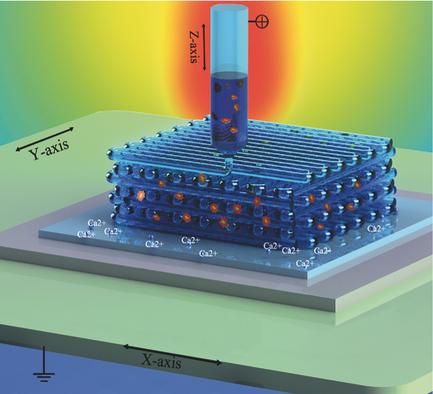Our official English website, www.x-mol.net, welcomes your
feedback! (Note: you will need to create a separate account there.)
Microscale Electro‐Hydrodynamic Cell Printing with High Viability
Small ( IF 13.0 ) Pub Date : 2017-11-02 , DOI: 10.1002/smll.201702626 Jiankang He 1 , Xiang Zhao 1 , Jinke Chang 1 , Dichen Li 1
Small ( IF 13.0 ) Pub Date : 2017-11-02 , DOI: 10.1002/smll.201702626 Jiankang He 1 , Xiang Zhao 1 , Jinke Chang 1 , Dichen Li 1
Affiliation

|
Cell printing has gained extensive attentions for the controlled fabrication of living cellular constructs in vitro. Various cell printing techniques are now being explored and developed for improved cell viability and printing resolution. Here an electro‐hydrodynamic cell printing strategy is developed with microscale resolution (<100 µm) and high cellular viability (>95%). Unlike the existing electro‐hydrodynamic cell jetting or printing explorations, insulating substrate is used to replace conventional semiconductive substrate as the collecting surface which significantly reduces the electrical current in the electro‐hydrodynamic printing process from milliamperes (>0.5 mA) to microamperes (<10 µA). Additionally, the nozzle‐to‐collector distance is fixed as small as 100 µm for better control over filament deposition. These features ensure high cellular viability and normal postproliferative capability of the electro‐hydrodynamically printed cells. The smallest width of the electro‐hydrodynamically printed hydrogel filament is 82.4 ± 14.3 µm by optimizing process parameters. Multiple hydrogels or multilayer cell‐laden constructs can be flexibly printed under cell‐friendly conditions. The printed cells in multilayer hydrogels kept alive and gradually spread during 7‐days culture in vitro. This exploration offers a novel and promising cell printing strategy which might benefit future biomedical innovations such as microscale tissue engineering, organ‐on‐a‐chip systems, and nanomedicine.
中文翻译:

具有高活力的微型电液细胞打印
细胞印刷已在体外控制活细胞构建体的制备中引起了广泛关注。现在正在探索和开发各种细胞印刷技术,以提高细胞活力和印刷分辨率。在这里,开发了一种电动液压细胞印刷策略,具有微米级分辨率(<100 µm)和高细胞存活率(> 95%)。与现有的电液动力电池喷射或印刷探索不同,绝缘基板被用来代替传统的半导电基板作为收集表面,从而在电液动力印刷过程中将电流从毫安(> 0.5 mA)降低至微安(<10) µA)。此外,喷嘴到收集器的距离固定为100 µm,以更好地控制灯丝沉积。这些特征确保了电液动力印刷细胞的高细胞活力和正常的增殖后能力。通过优化工艺参数,电动流体动力印刷水凝胶丝的最小宽度为82.4±14.3 µm。在对细胞友善的条件下,可以灵活地印刷多种水凝胶或多层含细胞的构建体。多层水凝胶中的印刷细胞在体外培养7天后保持活力并逐渐扩散。这项探索提供了一种新颖而有前途的细胞印刷策略,可能会有益于未来的生物医学创新,例如微型组织工程,芯片上的器官系统和纳米医学。通过优化工艺参数,电动流体动力印刷水凝胶丝的最小宽度为82.4±14.3 µm。在对细胞友善的条件下,可以灵活地印刷多种水凝胶或多层含细胞的构建体。多层水凝胶中的印刷细胞在体外培养7天后保持活力并逐渐扩散。这项探索提供了一种新颖而有前途的细胞印刷策略,可能会有益于未来的生物医学创新,例如微型组织工程,芯片上的器官系统和纳米医学。通过优化工艺参数,电动流体动力印刷水凝胶丝的最小宽度为82.4±14.3 µm。在对细胞友善的条件下,可以灵活地印刷多种水凝胶或多层含细胞的构建体。多层水凝胶中的印刷细胞在体外培养7天后保持活力并逐渐扩散。这项探索提供了一种新颖而有前途的细胞印刷策略,可能会有益于未来的生物医学创新,例如微型组织工程,芯片上的器官系统和纳米医学。
更新日期:2017-11-02
中文翻译:

具有高活力的微型电液细胞打印
细胞印刷已在体外控制活细胞构建体的制备中引起了广泛关注。现在正在探索和开发各种细胞印刷技术,以提高细胞活力和印刷分辨率。在这里,开发了一种电动液压细胞印刷策略,具有微米级分辨率(<100 µm)和高细胞存活率(> 95%)。与现有的电液动力电池喷射或印刷探索不同,绝缘基板被用来代替传统的半导电基板作为收集表面,从而在电液动力印刷过程中将电流从毫安(> 0.5 mA)降低至微安(<10) µA)。此外,喷嘴到收集器的距离固定为100 µm,以更好地控制灯丝沉积。这些特征确保了电液动力印刷细胞的高细胞活力和正常的增殖后能力。通过优化工艺参数,电动流体动力印刷水凝胶丝的最小宽度为82.4±14.3 µm。在对细胞友善的条件下,可以灵活地印刷多种水凝胶或多层含细胞的构建体。多层水凝胶中的印刷细胞在体外培养7天后保持活力并逐渐扩散。这项探索提供了一种新颖而有前途的细胞印刷策略,可能会有益于未来的生物医学创新,例如微型组织工程,芯片上的器官系统和纳米医学。通过优化工艺参数,电动流体动力印刷水凝胶丝的最小宽度为82.4±14.3 µm。在对细胞友善的条件下,可以灵活地印刷多种水凝胶或多层含细胞的构建体。多层水凝胶中的印刷细胞在体外培养7天后保持活力并逐渐扩散。这项探索提供了一种新颖而有前途的细胞印刷策略,可能会有益于未来的生物医学创新,例如微型组织工程,芯片上的器官系统和纳米医学。通过优化工艺参数,电动流体动力印刷水凝胶丝的最小宽度为82.4±14.3 µm。在对细胞友善的条件下,可以灵活地印刷多种水凝胶或多层含细胞的构建体。多层水凝胶中的印刷细胞在体外培养7天后保持活力并逐渐扩散。这项探索提供了一种新颖而有前途的细胞印刷策略,可能会有益于未来的生物医学创新,例如微型组织工程,芯片上的器官系统和纳米医学。











































 京公网安备 11010802027423号
京公网安备 11010802027423号